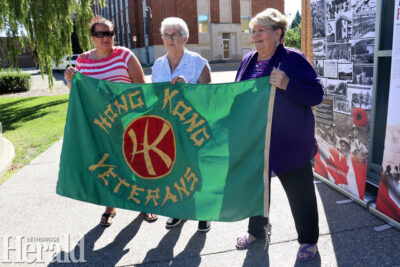Flag-raising remembers Hong Kong veterans
By Al Beeber - Lethbridge Herald on August 12, 2023.
 Herald photo by Al Beeber
Aleshia Melanson, her mom Cynthia Melanson and Kathie Carlson hold up the flag of the Hong Kong Veterans Commemorative Association at a flag-raising event Friday at the Cenotaph.
Herald photo by Al Beeber
Aleshia Melanson, her mom Cynthia Melanson and Kathie Carlson hold up the flag of the Hong Kong Veterans Commemorative Association at a flag-raising event Friday at the Cenotaph.LETHBRIDGE HERALDabeeber@lethbridgeherald.com
They were the first Canadian soldiers to head overseas in the Second World War and they were the last to return home after being freed from Japanese prisoner of war camps.
After arriving in Hong Kong in the fall of 1941, those who survived the invasion of the Crown colony by Japanese forces and the long incarceration in horrible conditions, the Canadians finally returned home in October of 1945.
Most had lost between 60 to 80 pounds during the course of their ordeal and forever after they were emotionally as well as physically scarred.
On Friday a flag-raising was staged at the Cenotaph at City Hall commemorating the end of the Second World War campaign in the Pacific on Aug. 15, 1945. That date is also the 30th anniversary of the Hong Kong Veterans Commemorative Association which is made up of family members of veterans who are committed to forever remembering the sacrifices those unheralded Canadians made for their country.
The Hong Kong soldiers from Canada were members of the Winnipeg Grenadiers and Royal Rifles. Their story is not as well known as others from different campaigns during the Second World War.
In late October, 1941, 1,976 Canadians set sail from Vancouver on board the Awatea and arrived in Hong Kong on Nov. 16.
The Canadians joined the Hong Kong defence force which consisted of 14,000 soldiers from Britain, India, Singapore and Hong Kong.
On Dec. 8, Japan attacked, crossing from China onto the mainland part of the colony After three days of battle the outnumbered defenders had been pushed off the mainland and back to Hong Kong proper. During fighting, D Company of Winnipeg Grenadiers became the first Canadian army unit to fight in the Second World War.
Twice – on Dec. 13 and 17th – Japan demanded that the defenders surrender but they were rebuffed both times.
On Dec. 18, Japanese forces crossed in darkness from the mainland and invaded, forcing defenders to draw back to the mountains. The inexperienced defenders, with no hope of reinforcements or supplies, finally surrendered on Christmas Day.
The Canadians were first held prisoner in Hong Kong until early 1943 and were moved to Japan until the droppings of two atomic bombs prompted Japan to surrender.
The Canadian POWs worked long hours as slave labour in mines, shipyards and on construction projects, living off a starvation diet while housed in primitive huts.
More than 260 of those Canadians died before they could be liberated. Of the Canadians who sailed to Hong Kong in 1941, more than 550 never returned home.
The flag raising is an annual event and this year attracted only the organizers, Kathie and John Carlson along with Cynthia Melanson and her daughter Aleshia.
Kathie and Cynthia are daughters of Hong Kong veterans, two Saskatchewan men named Leonard Corrigan and Joe Michalkow.
Neither man spoke of their experiences, their daughters said, with Kathie remembering how her dad and some of his buddies would get together over rum and Cokes and talk quietly among themselves. But the subject of Hong Kong was off-limits for other family members.
“There was a lot of alcoholism among them. They were very damaged when they came back,” said Carlson, the spokesperson for the association.
Virtually every son and daughter of a veteran will say they didn’t know what happened, said Carlson.
“They really suffered physically, mentally, emotionally, in every sense,” she added.
“Every father that we’ve ever heard about never told any of us and my father was no exception.”
The atomic bombs dropped on Aug. 6 and 9 on Hiroshima and Nagasaki swiftly ended the war.
“On August 15 of 1945, our fathers and all the rest of the POWs were liberated,” said Carlson, saying the soldiers “had to be fattened up” before starting the journey back to Canada.
“Every year what’s important is that we honour those veterans, our fathers, and never let we forget what they went through on behalf of our country…so many people aren’t as familiar with the Pacific war so much as the other theatres and so it’s our job to make people aware. They were the first Canadians to get in the war in ’41 and they were the last ones to come home in October, ’45,” said Carlson, who was putting up the flag Friday along with other associations across the country.
“It’s an acknowledgement these brave men really did whatever they could for their country,” said Carlson, noting only one veteran of the Hong Kong battles remains alive. He’s 106 years old living in Nova Scotia.
The association was started in the mid 1990s when the aging members of the Hong Kong Veterans association asked their sons and daughters to help, said Carlson of the organization whose role is education.
Follow @albeebHerald on Twitter
28-27


